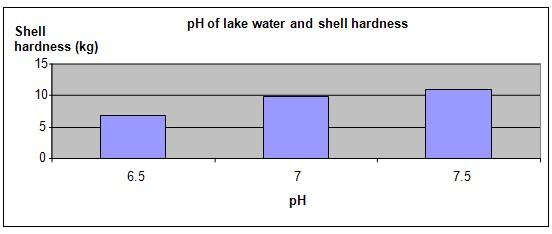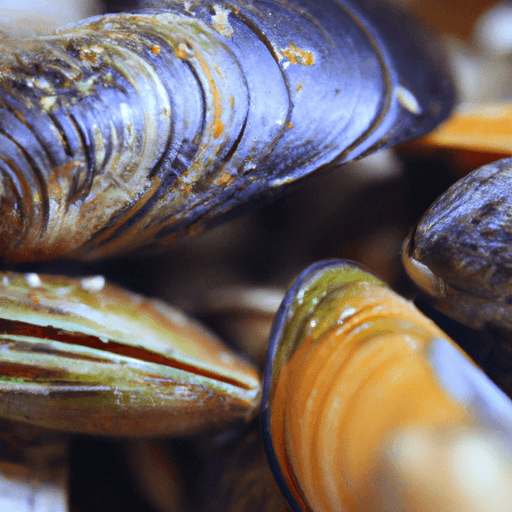| Complexity level: | 7 |
| Project cost ($): | 60 |
| Time required: | 1 day to prepare, 1 day for observation |
| Material availability: | You will need access to a hardness tester. You will also require transportation to travel to the lakes to gather mussel samples |
| Safety concerns: | Basic safety requirements |
Hypothesis
A lake with more acidic water will produce Zebra mussels with softer shells.
Overview
Zebra Mussels
Zebra mussels belong to a family of clams that have hard, elongated and asymmetrical shells. They are marked by alternating light and dark bands and normally live in slow moving or still fresh water. Zebra mussels will locate any hard surface under water and attach themselves to it. They are often found attached to rocks, buoys, boat hulls and submerged woods.
Zebra mussels usually require a small concentration of calcium in the water to grow their shells. They grow best and most quickly in waters of pH values between 7.4 and 8.4. Waters with pH levels below 6.8 is thought not to be conducive for their growth because the acidic waters may dissolve the shell. Although Zebra mussels can survive for a short while at temperatures below freezing, they thrive at temperatures between 20°C to 25°C. Apart from temperature, Zebra mussels are also sensitive to chemicals that are dissolved in the water and they can also detect touch and gravity.
Zebra mussels are filter feeders. They draw water into their incurrent siphon and then into the branchial chambers where their gills filter food from the water. The waste water then exit through the excurrent siphon. Their diet consists mainly of single-cell organisms such as bacteria, protozoa, plankton and algae.
There are many factors that determine the acidity of a lake, such as the amount of acid rain that the lake receives, whether livestock is found nearby, and whether nitrogen-based fertilizers are used in the vicinity. Also, the soil type in the surrounding catchment area plays a part in determining the acidity of lake water. If the soil is very alkaline in nature, it will neutralize the acid rain as the rain water seeps through the soil, on its way into the lake.
Scientific Terms
Materials
The materials required for this science fair project:
- 10 Zebra mussels from a lake with water at approximately pH6.5
- 10 Zebra mussels from a lake with water at approximatelypH7.0
- 10 Zebra mussels from a lake with water at approximately pH7.5
- You may need to enlist the help of an adult who can provide you with transport to lakes in the vicinity of where you live.
- A knife
- A manual hardness tester - check with your school's science laboratory if they have either manual or electric hardness testers
- Sufficient quantities of pH paper
- 3 plastic containers
- A black marker pen
Procedure
1. For this science fair project, the independent variable is the acidity of the lakes from which the Zebra mussels are harvested i.e. pH 6.5, pH7.0 and pH 7.5. The dependent variable is the hardness of the mussel shells. This is determined by using the manual hardness tester to check the hardness of the shell. The constants (control variables) are the age of the Zebra mussel, the amount of calcium in the water and the climate or temperature at the lakes.
2. The location of 3 lakes which contain Zebra mussels and are of different pH levels are selected. The preferred pH levels of the water in the lakes are pH 6.5 (acidic), 7.0 (neutral) and 7.5 (alkaline). A trip is made to the 3 lakes and their pH levels verified by testing the waters from the lake. 10 Zebra mussels are obtained from each lake and brought back to the lab for the remainder of the science fair project.
3. 3 plastic containers are labeled “pH 6.5”, “pH 7.0” and “pH 7.5”. The contents of the zebra mussel are removed from the shell. Wash the shells and placed inside the plastic containers according to the pH level markings of the lakes from which they were obtained.
4. The manual hardness tester is used to check the hardness of the shells. The average hardness for the 10 shells from each lake is recorded and the results recorded in the table below.

Results
It is observed that the Zebra mussels from the lake with pH 6.5 had softer shells and the mussels from the lake with pH 7.5 had the hardest shells.
| pH of lake water | 6.5 (acidic) | 7.0 (neutral) | 7.5 (alkaline) |
| Hardness of shell (kg) | 6.85 | 9.8 | 10.95 |
The graph below represents the results of our science project experiment:

Conclusion
The hypothesis that a lake with more acidic water will produce Zebra mussels with softer shells is proven correct.
Pollutant gasses released into the atmosphere by factories and vehicles return to us in the form of acid rain. The acidification of our oceans and fresh water lakes threatens the survival of plants, animals and fish that live in the water. Crustaceans and clams, are now more vulnerable because their shells, which are the only protection that they have, are slowly dissolving and weakening as a result of the acidification of water bodies such as lakes and oceans.
Also consider
What would happen if this science fair project were to be repeated with seawater mussels instead of freshwater mussels?
Would your results differ if a larger sample were to e used? (ie: samples of mussel shells from 20 different lakes, of varying pH levels?) Would the results be perhaps more accurate, given the larger sample?
You should also consider checking calcium levels in the water to ascertain if this makes a difference to your results.
References
Mussel - http://en.wikipedia.org/wiki/Mussel
Zebra mussel - http://animaldiversity.ummz.umich.edu/site/accounts/information/Dreissena_polymorpha.html

